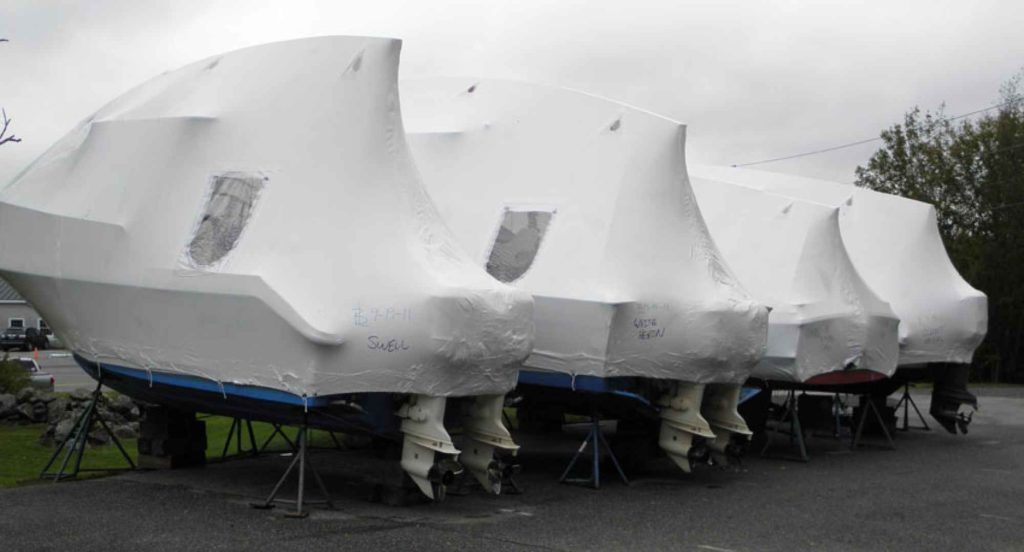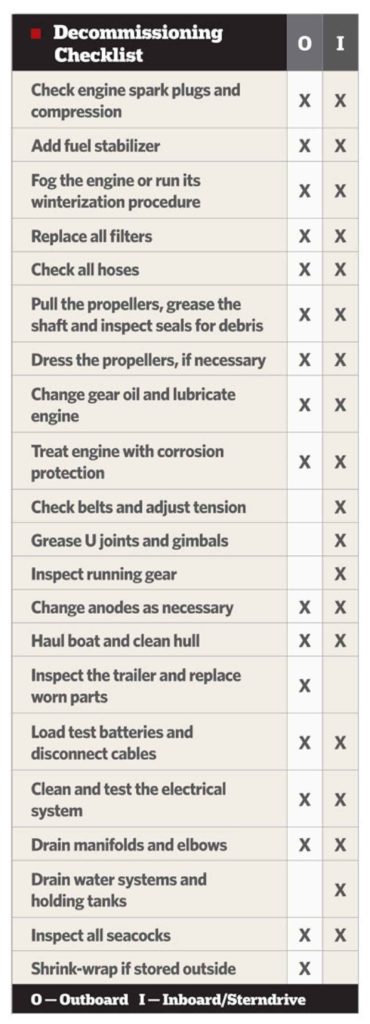
When my brother joined the ranks of proud boat owners a couple of years ago, he called after Labor Day looking for guidance. His dealer had recommended decommissioning his new walkaround and shrink-wrapping it for the winter. Since he lives outside Annapolis, Maryland, and I’m in Florida, I confessed to never winterizing a boat and suggested he follow that advice. He did, without regrets. Not everyone gets to fish in paradise year-round, and for those living above the Mason-Dixon Line, seasonal decommissioning is a necessity. So I checked in with a couple of pros to see what they do to tuck boats in for a long winter’s nap.
Power Down
“We winterize 400-plus boats every season and store about 250 at our facility,” says Howard “Howie” Kirkpatrick Jr., whose family has owned and operated BFC Marine, in Woolwich, Maine, since 1947. BFC specializes in outboard-powered boats in the 17- to 23-foot range. “The most important steps for outboards is to do a complete service, including a compression and spark-plug check, and then fog the engine. We are an Evinrude dealer, so we also check for any software updates and run the E-TEC winterization procedure.” Kirkpatrick’s technicians add fuel stabilizer to the tank before storage. Batteries receive special treatment too.
“We remove all batteries, clean the terminals and then trickle-charge them once a month to maintain a full charge,” Kirkpatrick says. “A good battery will last four to six years if you take care of it. Freezing weather zaps power and could damage the plates, so don’t store batteries on the concrete floor. Put them on a two-by-six board instead. And it’s important that you don’t overcook batteries when charging. Always use a charger that has an automatic shut-off or monitor to prevent overcharging and possible battery damage.”
Once all the service work is done, the boats are removed from the trailer and steam-cleaned before they are placed on racks in a heated storage barn. The bill for a complete winterization and interior storage ranges from $1,200 to $1,500. Kirkpatrick charges $300 for boats stored on the trailer in the yard. A contractor comes on site to shrink-wrap the boats stored outside.

Parts Prep
The complexity of today’s engines increases decommissioning costs, says Ereck Sullivan, the service manager for Bosun’s Marine, in Peabody, Massachusetts. The Yamaha four-stroke outboards that his dealership sells have one primary and up to three secondary fuel filters, and they should all be replaced when the boat is stored for the season. Fuel additives help extend the typical 28-day life of ethanol stored for prolonged periods. A local ordinance requires that boats at the Peabody facility be stored with full fuel tanks to minimize vapors, Sullivan adds, but empty tanks may be a better choice to combat condensation. With that option, you’ll have fresh fuel for the spring and avoid the risk of stored fuel going bad.
“It costs $150 for parts and labor to replace the fuel filters, but that’s a necessity with ethanol gas,” Sullivan says. “That’s cheap compared to the cost of replacing damaged fuel injectors.” Bosun’s Marine also drains the vapor-separator tank, completely services the engine and fogs it as part of the winterization process. Metal parts are all sprayed with corrosion retardant. On a Yamaha V-8 outboard, antifreeze must be added to the block.
“We load-test the batteries and disconnect the leads but leave the batteries in the boat,” Sullivan adds. “That’s the best place for them. If a battery is good in the fall, it’ll be good in the spring.”
A Pound of Cure
Boats 35 feet and larger typically stay in the water through the winter, Sullivan says, but annual servicing is still critical. Fall is the perfect time to haul out the boat and clean the bottom to remove marine growth. That also allows inspection of the running gear and propellers. The service regimen should include changing engine and gear oil, draining the manifold and all elbows, adding antifreeze and replacing anodes and impellers as necessary. All water systems, including raw and fresh, along with the head, must be winterized because of the threat of freezing temperatures.
Don’t forget about the boat’s electrical system either, Sullivan cautions. It should be completely checked, cleaned and sprayed with a corrosion-blocking compound. Winterization costs for a 24-foot boat with a single outboard, shrink-wrapped and stored, average around $2,200 at Bosun’s. For a 30-foot inboard-powered boat, that bumps up to $3,000 because of extra labor involved with the water systems.
“We like to do as much routine maintenance in the fall as possible, when we’re not so busy,” Sullivan adds. “That makes the spring commissioning less expensive, and on that first 75-degree day when everyone wants their boat, we can get them out fishing that much sooner.”
And that is the whole point of a thorough fall decommissioning — an ounce of prevention truly is worth a pound of cure.









